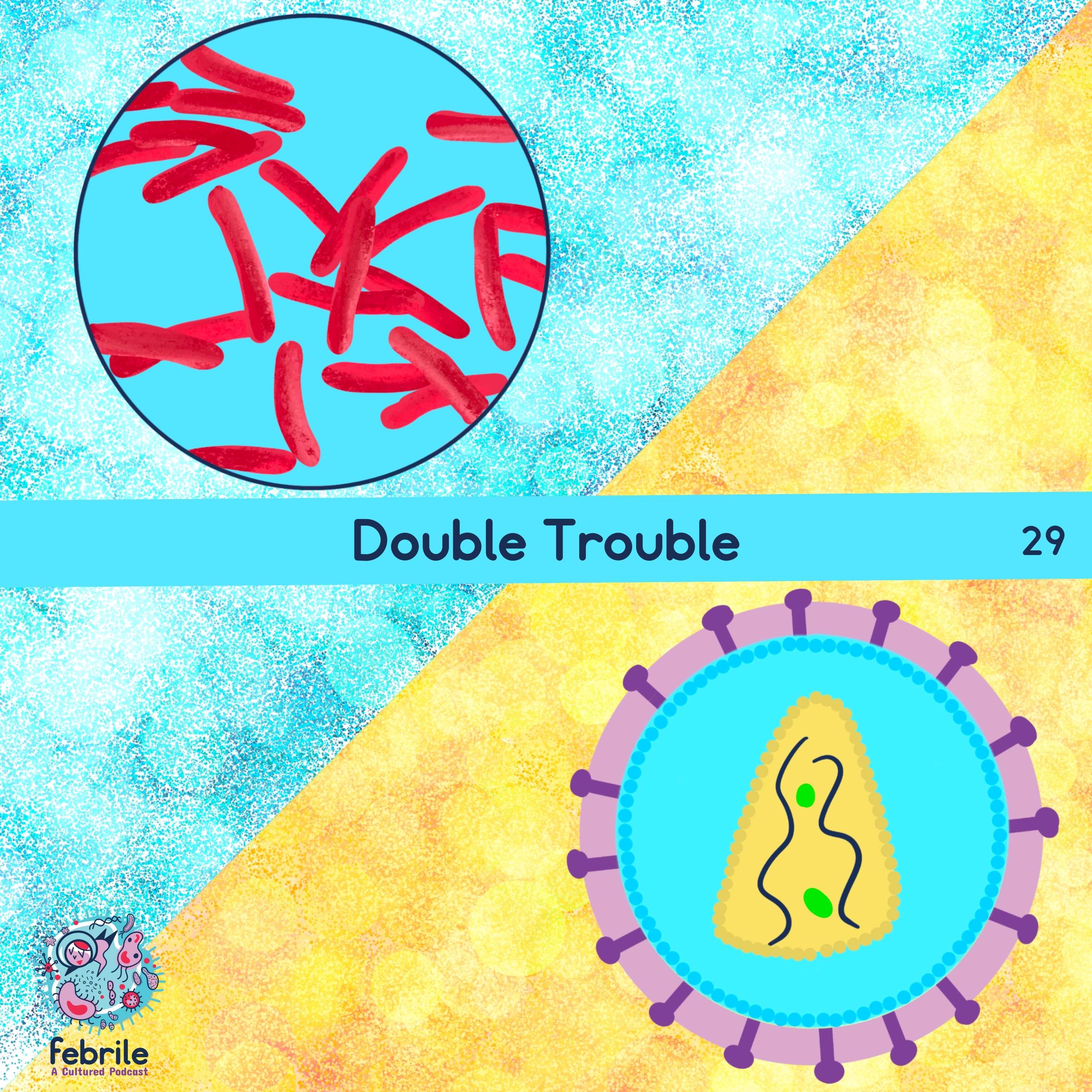Credits
Host(s): Alejandra Mendoza, Sara Dong
Guest: John Wilson
Writing: Alejandra Mendoza, Sara Dong
Producing/Editing/Cover Art/Infographics: Sara Dong
Our Guests
Guest Consultant
John Wilson, MD

Dr. John Wilson is a Consultant and Professor of Medicine in the Division of Infectious Diseases, Department of Internal Medicine at Mayo Clinic in Rochester, Minnesota. His current research and projects include: tuberculosis and non-tuberculous mycobacterial infection, TB drug pharmacokinetics in HIV co-infected patients, Pneumocystis PCR applications in immunocompromised hosts, HIV and TB health care in international resource impoverished areas among others. He completed his residency in Internal Medicine as well as his fellowship in Infectious Disease at Mayo Clinic.
Guest Co-Host
Alejandra Mendoza, MD

Dr. Alejandra Mendoza is an ID fellows at Mayo Clinic in Rochester, Minneosta
Consult Notes
Consult Q
Altered mental status of unclear cause
Case Summary
34 yo male who presented with altered mental status, shortness of breath, and dry cough who was found to have newly diagnosed HIV and disseminated TB infection.
Key Points
Jump to:

Survey Announcement
We are conducting a research survey to better understand listener utilization and satisfaction with the Febrile podcast and learning resource. We want to better understand how you use Febrile podcast to teach and learn, but also what we can do to improve for future episodes! The survey is open to anyone who has listened or viewed material from Febrile and is voluntary. This survey takes 5-10 minutes to complete, and responses are completely anonymous. If you have any questions about the survey, you can send me (Sara Dong) an email at swdong@bidmc.harvard.edu. Thank you!
Survey Link: https://hms.az1.qualtrics.com/jfe/form/SV_6o2iYLc1Sq7PMQC
This episode covered miliary pulmonary infiltrates again! Check out the prior graphic on this for a refresher and listen to the episode! This was similar to episode 27: Millet Seeds of Destruction. We’ll focus on TB and HIV for the remainder of the Consult Notes, but one quick reminder that came up: unlike cavitary disease, often miliary or extrapulmonary TB disease is more paucibacillary (and can lead to negative AFB smears)
A quick overview of CNS TB. We didn’t touch on all the forms of CNS infection due to M.tuberculosis, but as a quick reminder. CNS infection due to MTB affects ~1-5% of patients with TB and includes:
- Meningitis: we’ll talk more about this throughout the Consult Notes
- Tuberculoma: granulomatous focus from coalescing tubercles acquired during disseminated bacillemia; usually in brain but can occur in spinal cord
- Spinal arachnoiditis: breakdown of granulomatous foci in spinal cord or meninges and then tuberculous exudates encase spinal cord and spinal nerve roots with inflammatory reaction
In regions with high TB prevalence, all three forms are common among children and younger adults (given increased prevalence of postprimary dissemination). In areas like North America, extrapulmonary TB tends to represent adults with reactivation disease where the predominant form of CNS disease is meningitis. You can check out more about Reported TB in the US at CDC website here.
TB meningitis clinical features and complications
- Typical presentation: stiff neck, headache, fever, vomiting (similar to bacterial meningitis)
- Some features that might favor TB meningitis over bacterial meningitis include:
- Subacute presentation
- Presence of neurologic symptoms
- Presence of cranial nerve palsies (usually CN II, CN VI)
- TBM is classically described as having 3 phases:
- Early prodromal phase (1-3 wks): insidious malaise, headache, low grade fever, personality change
- Meningitic phase: pronounced neuro features such as meningismus, vomiting, CN signs
- Paralytic phase: confusion, stupor, coma, seizures, hemiparesis (death can ensue within 5-8 wks if untreated)
- In children, headache is often less frequent but children are more likely to have seizures
- Patients do not need to have pulmonary symptoms!!! Among patients with HIV co-infection and TBM though, concurrent TB elsewhere and in lung is more common
- Complications of TBM can include hydrocephalus, hyponatremia, and vision loss
TB meningitis diagnosis: Need a clinical suspicion! The diagnostics are challenging given their suboptimal sensitivity/specificity. See more below on what you might see and other notes
- CSF examination
- Opening pressure: usually elevated
- CSF fluid can have “ground-glass” appearance with delicate web-like clot at the top
- Cell count/diff:
- Often WBC ranges from 100-500 with lymphocyte predominance (up can be up to 1500 in 20% of cases)
- Early in illness though, a lower cell count +/- neutrophilic predominance may be present (this can also be seen in setting of spinal block and/or paradoxical worsening)
- CSF protein: elevated (usually 100-500 mg/dL)
- Very high protein in range of 2-6 g/dl is generally indicative of subarachnoid block and carries poor prognosis
- CSF glucose: typically low (<45 mg/dL)
- CSF smear and culture
- Sensitivity of AFB stain for TBM diagnosis: 30-60%
- Sensitivity of AFB culture for TBM diagnosis: <50% although some studies report closer to 85%
- Requires 3-6 wks for detectable growth
- Diagnostic yield is likely increased with multiple CSF specimens from repeated LPs and increased volumes (>=5 mL)
- Sensitivity of AFB smear/culture is maintained for a few days after starting treatment
- CSF M.tuberculosis NAAT
- Most important diagnostic tool! Faster turnaround time, high specificity (see Promohammad paper here for meta-analysis or below)
- Use in combination with AFB smear and culture
- Sensitivity maintained up to one month after treatment
- If available, urine-based detection of mycobacterial cell wall glycolipid lipoarabinomannan (urine LAM testing) has been recommended by WHO for TB dx in patients with HIV and can be used as CSF assay
- CSF adenosine deaminase (ADA)
- Can be a useful adjunct, but may be elevated with certain bacterial infections and neurobrucellosis (no threshold to differentiate between these)
- Don’t forget:
- CSF testing for other infections in differential, particularly CrAg
- Imaging with CT or MRI. Neuroimaging prior to LP is important particularly in setting of papilledema or signs of increased intracranial pressure (ICP)
- Don’t forget CXR and diagnostic evaluation of pulmonary TB as well as diagnostic evaluation for other sites of infection as necessary. Depending on the case, can sometimes complement work-up with urine or stool samples for TB, which can be markers for disseminated TB disease
TBM Resource Central!!! Here are some excellent resources for CNS TB
Available guidelines/guidance:
- ATS/CDC/IDSA Clinical Practice Guidelines: Treatment of Drug-Susceptible TB (as well as Drug-Resistant TB)
- Nahid P, Dorman SE, Alipanah N, et al. Official American Thoracic Society/Centers for Disease Control and Prevention/Infectious Diseases Society of America Clinical Practice Guidelines: Treatment of Drug-Susceptible Tuberculosis. Clin Infect Dis. 2016;63(7):e147-e195. doi:10.1093/cid/ciw3
- Nahid P, Mase SR, Migliori GB, et al. Treatment of Drug-Resistant Tuberculosis. An Official ATS/CDC/ERS/IDSA Clinical Practice Guideline [published correction appears in Am J Respir Crit Care Med. 2020 Feb 15;201(4):500-501]. Am J Respir Crit Care Med. 2019;200(10):e93-e142. doi:10.1164/rccm.201909-1874ST
- ATS/IDSA/CDC Clinical Practice Guidelines: Diagnosis of TB in Adults and Children
- British Infection Society Guidelines for diagnosis and treatment of TB of the CNS in adults and children
- WHO Guidelines for treatment of drug-susceptible tuberculosis and patient care, 2017 update
Reviews and other references:
- Review of CNS TB: Leonard JM. Central Nervous System Tuberculosis. Microbiol Spectr. 2017;5(2):10.1128/microbiolspec.TNMI7-0044-2017. doi:10.1128/microbiolspec.TNMI7-0044-2017
- Thwaites GE, Chau TT, Farrar JJ. Improving the bacteriological diagnosis of tuberculous meningitis. J Clin Microbiol. 2004;42(1):378-379. doi:10.1128/JCM.42.1.378-379.2004
- Pormohammad A, Nasiri MJ, McHugh TD, Riahi SM, Bahr NC. A Systematic Review and Meta-analysis of the Diagnostic Accuracy of Nucleic Acid Amplification Tests for Tuberculous Meningitis. J Clin Microbiol. 2019;57(6):e01113-18. Published 2019 May 24. doi:10.1128/JCM.01113-18
- Quinn CM, Kagimu E, Okirworth M, et al. Fujifilm SILVAMP TB LAM Assay on Cerebrospinal Fluid for the Detection of Tuberculous Meningitis in Adults With Human Immunodeficiency Virus. Clin Infect Dis. 2021;73(9):e3428-e3434. doi:10.1093/cid/ciaa1910
- Parra-Ruiz J, Ramos V, Dueñas C, et al. Rational application of adenosine deaminase activity in cerebrospinal fluid for the diagnosis of tuberculous meningitis. Infection. 2015;43(5):531-535. doi:10.1007/s15010-015-0777-7
CNS TB Treatment/Management
The first principle and key message: do NOT delay empiric therapy if suspect this diagnosis given high mortality and complication rate of untreated infection
- There are no RCTs to establish the optimal drug combination, dose, or duration of treatment for TBM
- The principles of treatment rely on pulmonary TB management
- Traditionally will have initial intensive phase (4 drugs x 2 months), followed by continuation phase (usually 2 drugs for 7-10 months) → total duration 9-12 months
- Treatment includes prompt TB therapy + glucocorticoids. Some patients with severe hydrocephalus may also require surgical consultation
- Current guidelines are largely based on pulmonary TB and may not take into account differential ability of TB drugs to penetrate the brain. Some challenges include:
- Anatomic distribution, quantity, and metabolic state of bacilli is poorly characterized
- Integrity of the BBB (related to infection, inflammation, blood supply) likely changes over course of treatment as antibiotics and anti-inflammatories given (affecting drug penetration)
- Not clear how mechanisms of bacterial killing influence host inflammatory response, vasculitis, strokes, risk of death
- So possible strategies to overcome these challenges have included:
- Prolonging treatment
- Increasing drug exposure in CNS
- Increasing dose of poorly penetrating drugs
- Add or replace drugs with different characteristics
Here are some notes and descriptions of the drugs in the context of TBM below:
- Rifampin (RIF)
- Your workhorse and a critical component
- Bactericidal; Active early against rapidly dividing organisms as well as semi-dormant organisms
- Achieves reliable CSF concentrations in presence of meningeal inflammation
- CNS penetration: 10-30%
- Use of higher dose rifampin warrants further study. Unlike some of the CDC recommendations, many experts in the TB community will use higher doses of rifampin right out of the gate (15-35 mg/kg/dose). As explained in the episode, we may be seeing CDC/WHO recommendations change to reflect elevated dosing in the coming year or two. Trials have evaluated high dose rifampin as strategy for treatment shortening in pulmonary TB and has also been evaluated as strategy to reduce mortality in TBM.
- In general, patients can tolerate higher doses and have favorable outcomes – but has not been associated with improved survival
- Follow therapeutic drug monitoring carefully
- Some references, particularly regarding high dosing of rifampin
- Heemskerk AD, Bang ND, Mai NT, et al. Intensified Antituberculosis Therapy in Adults with Tuberculous Meningitis. N Engl J Med. 2016;374(2):124-134. doi:10.1056/NEJMoa1507062
- van Toorn R, Schaaf HS, Laubscher JA, van Elsland SL, Donald PR, Schoeman JF. Short intensified treatment in children with drug-susceptible tuberculous meningitis. Pediatr Infect Dis J. 2014;33(3):248-252. doi:10.1097/INF.0000000000000065
- Heemskerk AD, Nguyen MTH, Dang HTM, et al. Clinical Outcomes of Patients With Drug-Resistant Tuberculous Meningitis Treated With an Intensified Antituberculosis Regimen. Clin Infect Dis. 2017;65(1):20-28. doi:10.1093/cid/cix230
- Dian S, Yunivita V, Ganiem AR, et al. Double-Blind, Randomized, Placebo-Controlled Phase II Dose-Finding Study To Evaluate High-Dose Rifampin for Tuberculous Meningitis. Antimicrob Agents Chemother. 2018;62(12):e01014-18. Published 2018 Nov 26. doi:10.1128/AAC.01014-18
- Yunivita V, Dian S, Ganiem AR, et al. Pharmacokinetics and safety/tolerability of higher oral and intravenous doses of rifampicin in adult tuberculous meningitis patients. Int J Antimicrob Agents. 2016;48(4):415-421. doi:10.1016/j.ijantimicag.2016.06.016
- Ding J, Thuy Thuong Thuong N, Pham TV, et al. Pharmacokinetics and Pharmacodynamics of Intensive Antituberculosis Treatment of Tuberculous Meningitis. Clin Pharmacol Ther. 2020;107(4):1023-1033. doi:10.1002/cpt.1783
- Isoniazid (INH)
- Diffuses readily into CSF with inflamed meninges; More active against rapidly dividing organisms
- Achieves concentrations higher than required for bactericidal activity
- Given pyridoxine concurrently
- Pyrazinamide (PZA)
- Penetrates readily into CSF
- Highly active against intracellular organisms
- Therapeutic efficacy enhanced when used with INH+RIF
- Caution: hepatotoxicity
- Fourth drug: there is a lack of consensus on this 4th drug. Options are outlined below:
- Ethambutol (EMB)
- Achieves moderately effective CSF concentrations but overall doesn’t penetrate well into CSF
- Has been debated whether other drugs should replace EMB as the fourth agent, such as the options below
- Levofloxacin or moxifloxacin (fluoroquinolones)
- Improved CNS penetration compared to EMB and high activity
- John spoke about how more and more centers and TB physicians rely on the utility of FQ to get into spinal fluid
- Important to check serum drug levels
- A phase II trial randomized TBM patients to higher IV dose of RIF and subsequently to standard, double, or no moxifloxacin → but use of moxifloxacin was not associated with survival benefit
- Levofloxacin has also failed to improve survival in Vietnam trials (unless INH-R disease)
- Meta-analysis of use of FQ in TBM used data from 1115 patients and did not recommend at this point
- Streptomycin (aminoglycosides)
- WHO guidelines favor streptomycin over ethambutol
- Ethambutol (EMB)
- Ethionamide
- In children, the AAP favors substitution of ethionamide or aminoglycoside in place of EMB in initial empiric treatment given difficulty associated with monitoring for optic neuritis
- Linezolid
- Seems successful in reaching CSF, only 2 studies have evaluated effects in TBM (both in China)
- Clofazamine or newer drugs?
Check out this reference paper: Cresswell FV, Te Brake L, Atherton R, et al. Intensified antibiotic treatment of tuberculosis meningitis. Expert Rev Clin Pharmacol. 2019;12(3):267-288. doi:10.1080/17512433.2019.1552831
HIV + TBM
In patients with CNS or disseminated TB and HIV co-infection, the most important priority is to start a TB regimen. Patient with HIV should use the same anti-TB agents as have been described with close attention to drug-drug interactions
For patients with CNS TB who are ART-naive, initiation of ART should be delayed due to concern for significant IRIS, which in the context of meningitis can increase risk of serious and fatal neurologic complications.
- The exact timing of this delay to ART initiation is somewhat controversial.
- Some experts and the ATS/IDSA TB treatment guidelines recommend delay for 1st 8 weeks of antiTB therapy regardless of CD4 count.
- This approach was based on this randomized trial of patients with TBM and HIV who were treated with immediate or deferred ART (2 months later). There was no difference in 9-month mortality, but patients who received immediate ART had more frequent life-threatening adverse events: Török ME, Yen NT, Chau TT, et al. Timing of initiation of antiretroviral therapy in human immunodeficiency virus (HIV)–associated tuberculous meningitis. Clin Infect Dis. 2011;52(11):1374-1383. doi:10.1093/cid/cir230
- Other experts favor early ART (within 2 weeks) after starting TB treatment for patients with more immunologically advanced HIV (CD4 <50)
- As discussed on the show, this comes down to a judgment call based on balancing risks and benefits.
- Some experts and the ATS/IDSA TB treatment guidelines recommend delay for 1st 8 weeks of antiTB therapy regardless of CD4 count.
- The trials that John mentioned on the show relating to initiation of ART in relation to TB:
- SAPiT (Starting ART at three points in TB): Abdool Karim SS, Naidoo K, Grobler A, et al. Timing of initiation of antiretroviral drugs during tuberculosis therapy. N Engl J Med. 2010;362(8):697-706. doi:10.1056/NEJMoa0905848
- CAMELIA (Cambodian Early vs Late introduction of antiretrovirals): Blanc FX, Sok T, Laureillard D, et al. Earlier versus later start of antiretroviral therapy in HIV-infected adults with tuberculosis. N Engl J Med. 2011;365(16):1471-1481. doi:10.1056/NEJMoa1013911
- STRIDE: Havlir DV, Kendall MA, Ive P, et al. Timing of antiretroviral therapy for HIV-1 infection and tuberculosis. N Engl J Med. 2011;365(16):1482-1491. doi:10.1056/NEJMoa1013607
Steroids
- Role of adjunctive corticosteroid therapy in treatment of suspected or confirmed TBM has been reported in numerous studies
- Optimal approach is uncertain but generally recommended in an effort to reduce inflammation, limit damage to CNS, and improve outcomes
- Randomized trials have demonstrated mortality benefit associated with steroids in patients without HIV
- Among patients with HIV, efficacy is less clear
- Some references:
- Thwaites GE, Nguyen DB, Nguyen HD, et al. Dexamethasone for the treatment of tuberculous meningitis in adolescents and adults. N Engl J Med. 2004;351(17):1741-1751. doi:10.1056/NEJMoa040573
- Schoeman JF, Van Zyl LE, Laubscher JA, Donald PR. Effect of corticosteroids on intracranial pressure, computed tomographic findings, and clinical outcome in young children with tuberculous meningitis. Pediatrics. 1997;99(2):226-231. doi:10.1542/peds.99.2.226
- Girgis NI, Farid Z, Kilpatrick ME, Sultan Y, Mikhail IA. Dexamethasone adjunctive treatment for tuberculous meningitis. Pediatr Infect Dis J. 1991;10(3):179-183. doi:10.1097/00006454-199103000-00002
- Prasad K, Singh MB, Ryan H. Corticosteroids for managing tuberculous meningitis. Cochrane Database Syst Rev. 2016;4(4):CD002244. Published 2016 Apr 28. doi:10.1002/14651858.CD002244.pub4
At the end of the episode, we also touched on how hepatic insufficiency impacts our TB drug selection and the complications you encounter when creating a liver sparing regimen. A few points made by John:
- INH, RIF, PZA all are metabolized by the liver
- RIF is probably the least of these offenders and remains the most important drug for TB → so we want to prioritize a rif-containing regimen
- Sometimes you have to consider a liver biopsy to determine whether LFT elevation is related to TB infection or something else
TBM Outcomes
- Incidence of morbidity/deficits in treated disease varies in 10-30% in some series, and includes: CN palsies, gait disturbance, hemiplegia, blindness, deafness, learning disabilities, dementia, and syndromes of hypothalamic and pituitary dysfunction
- Mortality associated with TBM is as high as 55-75% in adults, especially in those with HIV infection and those with advanced disease on presentation
- Mortality associated with TBM is ~20% in children
- Among patients with TBM, clinical stage at time of therapy initiation affects mortality and incidence of subsequent neurologic sequelae
- Kennedy DH, Fallon RJ. Tuberculous meningitis. JAMA. 1979;241(3):264-268. —Delay in treatment was associated with deterioration and poorer prognosis in this series of 52 cases (age range 9 mo – 68 yrs). When therapy was started before patients had progressed beyond clinical stage 1 or early stage 2, mortality rate <10% and residual neuro deficits minimal. Of 11 patients at stage 3 at time of treatment, 6 died or suffered severe neuro sequelae
- Kent SJ, Crowe SM, Yung A, Lucas CR, Mijch AM. Tuberculous meningitis: a 30-year review. Clin Infect Dis. 1993;17(6):987-994. doi:10.1093/clinids/17.6.987 — Pts at stage 3 had poor prognosis, even when treatment begun on day of admission. All 8 died or developed severe neuro deficit
- Verdon R, Chevret S, Laissy JP, Wolff M. Tuberculous meningitis in adults: review of 48 cases. Clin Infect Dis. 1996;22(6):982-988. doi:10.1093/clinids/22.6.982 — 48 patients with TBM admitted to intensive care, mortality 65%. Factors associated with poor outcome: clinical stage at admission, delay in treatment initiation >=3 days
- Are there any models able to help with predictions of disease?
- Clinical scoring systems and prognostic models have been developed to attempt to identify patients at greater risk of death → however disease complications that may change likelihood of poor outcomes are not often captured by models which use baseline data
- Thao LTP, Wolbers M, Heemskerk AD, et al. Dynamic Prediction of Death in Patients With Tuberculous Meningitis Using Time-updated Glasgow Coma Scale and Plasma Sodium Measurements. Clin Infect Dis. 2020;70(5):827-834. doi:10.1093/cid/ciz262 — Dynamic prediction model developed from data from 1048 adults with TBM from 3 RCTs and 1 prospective observational study at 2 Vietnmaese hospitals from 2004-2016
- Incorporated follow-up measurements of GCS and plasma Na
- In both HIV-infected and HIV co-infected individuals, higher GCS indicated lower mortality with hazard ratios of 0.76 (95% CI 0.81-0.81) and 0.85 (95% CI 0.81-0.91), respectively
- In HIV-infected pts, higher plasma Na uniformly associated with good prognosis (more heterogenous in HIV-uninfected group)
- Donovan J, Thwaites GE, Huynh J. Tuberculous meningitis: where to from here?. Curr Opin Infect Dis. 2020;33(3):259-266. doi:10.1097/QCO.0000000000000648
Episode Art & Infographics
Goal
Listeners will be able to create an initial evaluation and treatment regimen for a patient with HIV and TB meningitis co-infection
Learning Objectives
After listening to this episode, listeners will be able to:
- Compare and contrast diagnostic tests available for TB meningitis
- Describe the components of an initial treatment regimen for TB meningitis
- Identify the appropriate time frames for initiation of HIV antiretrovirals in the setting of central nervous system TB disease
Disclosures
Our guest (John Wilson) as well as Febrile podcast and hosts report no relevant financial disclosures
Citation
Wilson, J., Mendoza, A., Dong, S. “#29: Double Trouble”. Febrile: A Cultured Podcast. https://player.captivate.fm/episode/704adbe3-b236-4f77-87ae-0e95f52f1432



